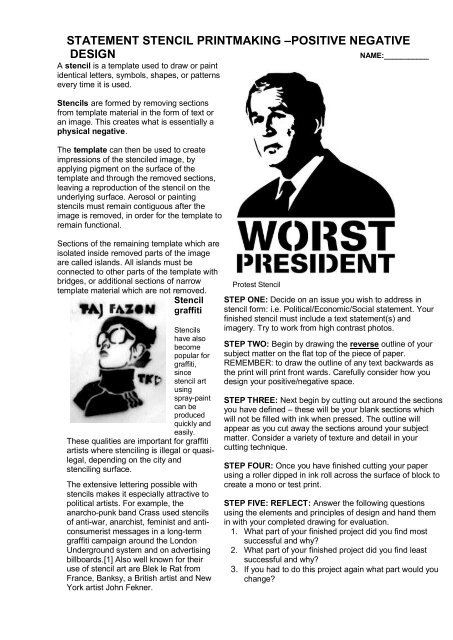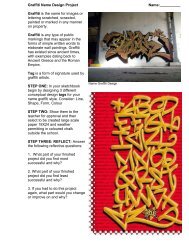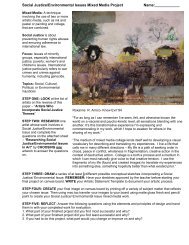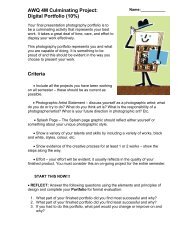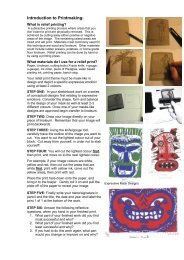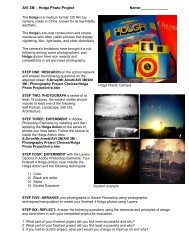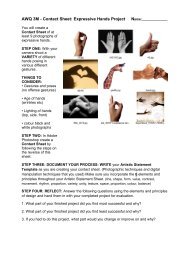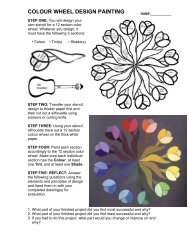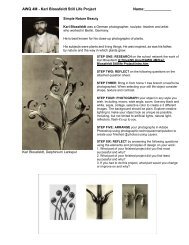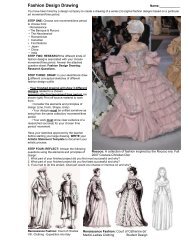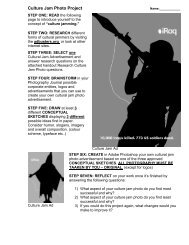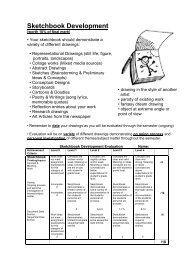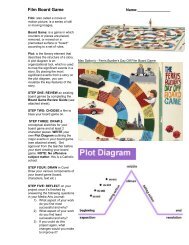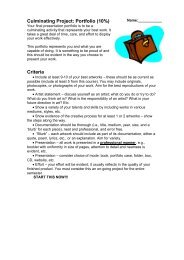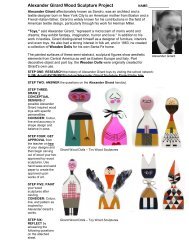statement stencil printmaking –positive negative design
statement stencil printmaking –positive negative design
statement stencil printmaking –positive negative design
Create successful ePaper yourself
Turn your PDF publications into a flip-book with our unique Google optimized e-Paper software.
STATEMENT STENCIL PRINTMAKING –POSITIVE NEGATIVE<br />
DESIGN NAME:___________<br />
A <strong>stencil</strong> is a template used to draw or paint<br />
identical letters, symbols, shapes, or patterns<br />
every time it is used.<br />
Stencils are formed by removing sections<br />
from template material in the form of text or<br />
an image. This creates what is essentially a<br />
physical <strong>negative</strong>.<br />
The template can then be used to create<br />
impressions of the <strong>stencil</strong>ed image, by<br />
applying pigment on the surface of the<br />
template and through the removed sections,<br />
leaving a reproduction of the <strong>stencil</strong> on the<br />
underlying surface. Aerosol or painting<br />
<strong>stencil</strong>s must remain contiguous after the<br />
image is removed, in order for the template to<br />
remain functional.<br />
Sections of the remaining template which are<br />
isolated inside removed parts of the image<br />
are called islands. All islands must be<br />
connected to other parts of the template with<br />
bridges, or additional sections of narrow<br />
template material which are not removed.<br />
Stencil<br />
graffiti<br />
Stencils<br />
have also<br />
become<br />
popular for<br />
graffiti,<br />
since<br />
<strong>stencil</strong> art<br />
using<br />
spray-paint<br />
can be<br />
produced<br />
quickly and<br />
easily.<br />
These qualities are important for graffiti<br />
artists where <strong>stencil</strong>ing is illegal or quasilegal,<br />
depending on the city and<br />
<strong>stencil</strong>ing surface.<br />
The extensive lettering possible with<br />
<strong>stencil</strong>s makes it especially attractive to<br />
political artists. For example, the<br />
anarcho-punk band Crass used <strong>stencil</strong>s<br />
of anti-war, anarchist, feminist and anticonsumerist<br />
messages in a long-term<br />
graffiti campaign around the London<br />
Underground system and on advertising<br />
billboards.[1] Also well known for their<br />
use of <strong>stencil</strong> art are Blek le Rat from<br />
France, Banksy, a British artist and New<br />
York artist John Fekner.<br />
Protest Stencil<br />
STEP ONE: Decide on an issue you wish to address in<br />
<strong>stencil</strong> form: i.e. Political/Economic/Social <strong>statement</strong>. Your<br />
finished <strong>stencil</strong> must include a text <strong>statement</strong>(s) and<br />
imagery. Try to work from high contrast photos.<br />
STEP TWO: Begin by drawing the reverse outline of your<br />
subject matter on the flat top of the piece of paper.<br />
REMEMBER: to draw the outline of any text backwards as<br />
the print will print front wards. Carefully consider how you<br />
<strong>design</strong> your positive/<strong>negative</strong> space.<br />
STEP THREE: Next begin by cutting out around the sections<br />
you have defined – these will be your blank sections which<br />
will not be filled with ink when pressed. The outline will<br />
appear as you cut away the sections around your subject<br />
matter. Consider a variety of texture and detail in your<br />
cutting technique.<br />
STEP FOUR: Once you have finished cutting your paper<br />
using a roller dipped in ink roll across the surface of block to<br />
create a mono or test print.<br />
STEP FIVE: REFLECT: Answer the following questions<br />
using the elements and principles of <strong>design</strong> and hand them<br />
in with your completed drawing for evaluation.<br />
1. What part of your finished project did you find most<br />
successful and why?<br />
2. What part of your finished project did you find least<br />
successful and why?<br />
3. If you had to do this project again what part would you<br />
change?
Japanese Woodcut<br />
Katsushika Hokusai (Japanese, 1760-1849)<br />
South Wind, Clearing Skies, from the series Thirty-six Views of Mt. Fuji, ca.<br />
1829-33 color woodblock print 10 1/16 x 14 7/8 in. (25.5 x 38 cm)<br />
Protest Stencil Examples<br />
Anti War Stencil - Josh McPhee<br />
Stencil History<br />
Stencils may have been used to<br />
color cloth for a very long time;<br />
the technique probably reached<br />
its peak of sophistication in<br />
Katazome and other techniques<br />
used on silks for clothes during<br />
the Edo period in Japan.<br />
In Europe, from about 1450 they<br />
were very commonly used to colour<br />
old master prints printedin black and<br />
white, usually woodcuts. This was<br />
especially the case with playing-<br />
cards, which continued to be<br />
coloured by <strong>stencil</strong> long after most<br />
other subjects for prints were left in<br />
black and white. Stenciling back in<br />
the 2600 BC's was different. They<br />
used color from plants and flowers<br />
such as indigo (which extracts blue).<br />
Stencils were<br />
used for mass publications, as<br />
the type didn't have to be handwritten.<br />
The first book to be<br />
printed using <strong>stencil</strong>s was the bible.
Stencil Printmaking–Positive Negative Design Name:_____________<br />
Knowledge/<br />
Understanding<br />
Demonstrates<br />
understanding of the<br />
elements & principles<br />
of <strong>design</strong> in the<br />
<strong>stencil</strong> (e.g. form, line,<br />
contrast)<br />
Thinking/<br />
Inquiry<br />
Concept:<br />
Positive Negative<br />
process: Statement<br />
Communication<br />
Clarity:<br />
Explains use of<br />
<strong>stencil</strong> techniques<br />
Reflective Questions<br />
Application<br />
Creative Process:<br />
Ability to solve a<br />
series of artistic<br />
problems, showing<br />
an awareness of<br />
formal qualities,<br />
visual conventions,<br />
and relevant ideas<br />
and concepts.<br />
Creative Process:<br />
Demonstration of<br />
Skill Development &<br />
following procedures<br />
including Clean Up<br />
Uses elements &<br />
principles of <strong>design</strong><br />
& <strong>stencil</strong> techniques<br />
to produce an<br />
effective artwork –<br />
line, shape, contrast<br />
Level 0<br />
Work does not<br />
meet<br />
assignments<br />
expectations for<br />
this category.<br />
Incomplete.<br />
0<br />
Work does not<br />
meet<br />
assignments<br />
expectations for<br />
this category.<br />
Incomplete.<br />
0<br />
Work does not<br />
meet<br />
assignments<br />
expectations for<br />
this category.<br />
Incomplete.<br />
0<br />
Incomplete.<br />
0<br />
Work does not<br />
meet<br />
assignments<br />
expectations for<br />
this category.<br />
Incomplete.<br />
0<br />
Incomplete.<br />
0<br />
Incomplete.<br />
0<br />
Level 1<br />
Student<br />
demonstrates<br />
limited<br />
understanding of<br />
the elements &<br />
principles of <strong>design</strong><br />
in the <strong>stencil</strong>.<br />
0.25<br />
Concept and<br />
context is unclear<br />
and/or weak.<br />
Meaning or ideas<br />
conveyed are not<br />
on par with student<br />
grade level.<br />
0.25<br />
Student explains<br />
use of painting &<br />
<strong>stencil</strong> techniques<br />
with limited clarity.<br />
0.25<br />
Poor, yes/no<br />
answers/limited<br />
incomplete.<br />
0.25<br />
Concepts are<br />
poor/incomplete.<br />
Planning is<br />
tentative or nonexistent.<br />
(0.5)<br />
0.5<br />
Student<br />
demonstrates<br />
limited<br />
effectiveness in<br />
demonstrating the<br />
creative process<br />
and following<br />
procedures.<br />
5<br />
Student<br />
demonstrates<br />
limited use of the e<br />
& ps of <strong>design</strong> and<br />
sculpture<br />
techniques to<br />
produce an art<br />
work of limited<br />
effectiveness.<br />
1<br />
Level 2<br />
Student demonstrates<br />
some understanding<br />
of the elements &<br />
principles of <strong>design</strong> in<br />
the <strong>stencil</strong>.<br />
0.50<br />
Concept and context<br />
is slightly unclear<br />
and/or weak.<br />
Meaning or ideas<br />
conveyed are below<br />
expectations for<br />
student’s grade level.<br />
0.50<br />
Student explains use<br />
of painting & <strong>stencil</strong><br />
techniques with some<br />
clarity.<br />
0.50<br />
Somewhat coherent<br />
and somewhat<br />
complete. 0.50<br />
Concepts are<br />
somewhat complete.<br />
Planning is somewhat<br />
substantial & shows<br />
some alternative<br />
ideas. (0.5-1)<br />
1<br />
Student demonstrates<br />
some effectiveness in<br />
demonstrating the<br />
creative process and<br />
following procedures.<br />
5-6<br />
Student demonstrates<br />
some use of the e &<br />
ps of <strong>design</strong> and<br />
sculpture techniques<br />
to produce an art<br />
work of some<br />
effectiveness.<br />
2-3<br />
Level 3<br />
Student demonstrates<br />
considerable<br />
understanding of the<br />
elements & principles<br />
of <strong>design</strong> in the<br />
<strong>stencil</strong>.<br />
0.75<br />
Concept and context<br />
is clear and valid.<br />
Meaning or ideas<br />
conveyed are on par<br />
with student’s grade<br />
level.<br />
0.75<br />
Student explains use<br />
of painting & <strong>stencil</strong><br />
techniques with<br />
considerable clarity.<br />
0.75<br />
Clear and substantial<br />
answers.<br />
0.75<br />
Planning is evident &<br />
shows some<br />
divergent thinking is<br />
evident. (1-1.5)<br />
1-1.75<br />
Student demonstrates<br />
considerable<br />
effectiveness in<br />
demonstrating the<br />
creative process and<br />
following procedures.<br />
7-8<br />
Student demonstrates<br />
considerable use of<br />
the e & ps of<br />
sculpture and painting<br />
techniques to produce<br />
an art work of<br />
considerable<br />
effectiveness.<br />
3-4<br />
Level 4<br />
Student<br />
demonstrates<br />
a high degree of<br />
understanding of<br />
the elements &<br />
principles of <strong>design</strong><br />
in the <strong>stencil</strong>.<br />
1<br />
Concept and<br />
context is clear<br />
and strong.<br />
Meaning or ideas<br />
conveyed are<br />
above<br />
expectations for<br />
grade level. 1<br />
Student explains<br />
use of <strong>stencil</strong><br />
techniques with a<br />
high degree of<br />
clarity.<br />
1<br />
Superior and<br />
insightful answers.<br />
1<br />
Concepts are fully<br />
developed.<br />
Planning is<br />
exceptional &<br />
shows<br />
considerable<br />
flexibility in<br />
thinking. (2)<br />
2<br />
Student<br />
demonstrates<br />
superior<br />
effectiveness in<br />
demonstrating the<br />
creative process<br />
and following<br />
procedures.<br />
8- 10<br />
Student<br />
demonstrates a<br />
high degree of<br />
using the e & ps of<br />
<strong>design</strong> and<br />
sculpture<br />
techniques to<br />
produce a highly<br />
effective art work.<br />
5<br />
A1. The Creative Process: apply the creative process to create a variety of art works, individually and/or collaboratively;<br />
A1.1 use a variety of strategies, individually and/or collaboratively, to generate Ideas and to develop plans for the creation of art works (e.g.,<br />
in small groups, use brainstorming, research, concept webs, and/or mind maps to generate original and imaginative ideas; filter their ideas to<br />
select a suitable one to serve as the basis for their art work; use notes and/or thumbnail sketches to help them develop clear and flexible<br />
plans that show attention to detail; revise their plans on the basis of peer- and self-assessment)<br />
A1.2 use experimentation, reflection, and revision when producing a variety of art works in each of the following areas: drawing, sculpture,<br />
painting, <strong>printmaking</strong>, and mixed media (e.g., experiment with a variety of materials/media, techniques, and tools to find ones that are<br />
appropriate for their planned art work; reflect on their preliminary work and on feedback from their peers before revising their art work)<br />
A1.3 document their use of the creative process in a portfolio (e.g., include evidence of their conceptual, creative, and technical skills; include<br />
thumbnail sketches, checklists, and/or graphic organizers to show evidence of experimentation, reflection, and revision), and refer to this<br />
portfolio to reflect on how effectively they have used the creative process<br />
A2. The Elements and Principles of Design: apply elements and principles of <strong>design</strong> to create artworks for the purpose of self-expression and to<br />
communicate ideas, information, and/or messages;<br />
A2.1 use various elements and principles of <strong>design</strong> to create art works that express personal feelings and/or communicate emotions to an<br />
audience (e.g., create a mixed-media self-portrait that uses colour, line, and shape in the style of Frida Kahlo to convey their personality and<br />
elicit emotions from the audience)<br />
A2.2 apply elements and principles of <strong>design</strong> as well as art-making conventions to create art works that communicate ideas, information, or<br />
messages, and/or that convey a point of view on an issue (e.g., use colour, line, shape, contrast, and emphasis when creating a graffiti piece<br />
that addresses an issue in their local community; incorporate symbolism to communicate a message about an environmental issue)<br />
A3. Production and Presentation: produce art works, using a variety of media/materials and traditional and/or emerging technologies, tools, and<br />
techniques, and demonstrate an understanding of a variety of ways of presenting their works and the works of others.<br />
/1<br />
/1<br />
/1<br />
/1<br />
/2<br />
/10<br />
/5<br />
/21
3.1 explore and experiment with a variety of materials/media, including alternative media, and traditional and/or emerging technologies, tools,<br />
and techniques, and apply them to create art works<br />
B1. The Critical Analysis Process: demonstrate an understanding of the critical analysis process by examining, interpreting, evaluating, and reflecting<br />
on various art works;<br />
B1.1 identify and describe their initial reactions to a variety of art works, and explain the reasons for their reactions (e.g., the aspects of the<br />
work and/or their personal experiences that contributed to their first impressions of its mood, subject, intent)<br />
B1.2 identify and describe the elements and principles of <strong>design</strong> used in their own art works and the works of others, and describe their<br />
effects (e.g., how line, colour, and shape are used to create emphasis, mood, and/or movement)<br />
B1.4 use a variety of strategies (e.g., peer- and self-assessment, formal critiques, feedback and reflection following public displays) to<br />
identify and reflect on the qualities of their own art works and the works of others, and evaluate the effectiveness of these works<br />
C1. Terminology: demonstrate an understanding of, and use correct terminology when referring to, elements, principles, and other components related<br />
to visual arts;<br />
C1.1 use appropriate terminology related to elements and principles of <strong>design</strong> when creating and analysing art works<br />
C1.2 use appropriate vocabulary to describe techniques, materials, and tools when creating and presenting visual art works<br />
C1.3 identify and describe the stages of the creative process and the critical analysis process (e.g., how reflection relates to the other stages<br />
of the creative process)<br />
C2. Conventions and Techniques: demonstrate an understanding of conventions and techniques used in the creation of visual art works;<br />
C2.1 demonstrate an understanding of a variety of techniques that artists use to achieve specific effects<br />
C2.2 demonstrate an understanding of several conventions used in visual art works (e.g., exaggeration, metaphor, simile, symbols,<br />
synectics; conventions associated with heroic, narrative, naturalistic, and satirical works)<br />
C3. Responsible Practices: demonstrate an understanding of responsible practices in visual arts.<br />
C3.2 demonstrate an understanding of safe and conscientious practices associated with the use of materials, tools, and technologies in<br />
visual arts, and apply these practices when creating and/or presenting art works (e.g., use appropriate precautions when dealing with<br />
hazardous materials; adopt protective measures when using sharp tools; keep their work space clean and free of physical and other hazards;<br />
demonstrate respect for classroom facilities, tools, equipment, and technological devices)


